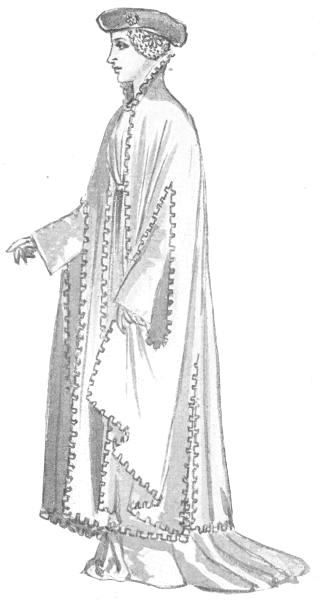Houppelande on:
[Wikipedia]
[Google]
[Amazon]
 A houppelande or houpelande is an outer
A houppelande or houpelande is an outer
File:Prayer_book_of_Maria_d'Harcourt_-_Staatsbibliothek_zu_Berlin_MsGermQuart42_-_f19v.jpg, Woman wearing a houppelande with "dagged" sleeves.
File:Départ_pour_un_pèlerinage_-_Petites_Heures_du_duc_de_Berry_-_BNF_Lat18014_f288v.jpg, The man on the right wears a belted houppelande and a chaperon hat.
File:Les Très Riches Heures du duc de Berry avril.jpg, Houppelande examples from
 A houppelande or houpelande is an outer
A houppelande or houpelande is an outer garment
Clothing (also known as clothes, garments, dress, apparel, or attire) is any item worn on a human human body, body. Typically, clothing is made of fabrics or textiles, but over time it has included garments made from animal skin and other thin s ...
, with a long, full body and flaring sleeves, that was worn by both men and women in Europe
Europe is a continent located entirely in the Northern Hemisphere and mostly in the Eastern Hemisphere. It is bordered by the Arctic Ocean to the north, the Atlantic Ocean to the west, the Mediterranean Sea to the south, and Asia to the east ...
in the late Middle Ages
In the history of Europe, the Middle Ages or medieval period lasted approximately from the 5th to the late 15th centuries, similarly to the post-classical period of global history. It began with the fall of the Western Roman Empire and ...
. Sometimes the houppelande was lined with fur
A fur is a soft, thick growth of hair that covers the skin of almost all mammals. It consists of a combination of oily guard hair on top and thick underfur beneath. The guard hair keeps moisture from reaching the skin; the underfur acts as an ...
. The garment was later worn by professional classes, and has remained in Western civilization
Western culture, also known as Western civilization, European civilization, Occidental culture, Western society, or simply the West, refers to the internally diverse culture of the Western world. The term "Western" encompasses the social no ...
as the familiar academic
An academy (Attic Greek: Ἀκαδήμεια; Koine Greek Ἀκαδημία) is an institution of tertiary education. The name traces back to Plato's school of philosophy, founded approximately 386 BC at Akademia, a sanctuary of Athena, the go ...
and legal robes of today. However, back then it was always worn over a doublet by men.
The houppelande appeared around 1360 and was to remain fashionable well into the next century. It had its origins in the herigaut, a similar 13th-century garment with hanging sleeves. The edges of the houppelande were often ''dagged'', or cut into decorative patterns such as scallops, "embattled" tabs or even leaf shapes.Ribiero, Aileen, ''Dress and Morality'', Batsford, 1986, reprinted Berg, 2003,
History
The term ''houppelande'' is of French origin; in England it was called a ''goun'', a term of mockery, and in Italy, a ''pellanda''. It is first mentioned in French royal inventories in 1359 and is thought to have originated as a man's housecoat worn over the pourpoint. The woman's and man's houppelande were similar in that both featured flared sleeves, high collars and voluminous skirts. However, there were a few key differences. The man's houppelande was belted at the waist, whereas the woman's was belted beneath the bust. Unlike the woman's houppelande, which was always floor-length, the man's houppelande could be of any length. Some men wore houppelandes that extended only as far as the buttocks, prompting critics to claim that they looked like women from behind. Longer versions were mostly worn on ceremonial occasions. A mid-calf version known as the ''houppelande à mi-jambe'' gained popularity in the 1400s.Gallery
Très Riches Heures du Duc de Berry
The (; ), or , is an illuminated manuscript that was created between and 1416. It is a book of hours, which is a Christians, Christian devotional book and a collection of prayers said at canonical hours. The manuscript was created for John, ...
, avril
See also
*1300–1400 in European fashion
Fashion in fourteenth-century Europe was marked by the beginning of a period of experimentation with different forms of clothing. Costume historian James Laver suggests that the mid-14th century marks the emergence of recognizable "fashion" in cl ...
*1400–1500 in European fashion
Fashion in 15th-century Europe was characterized by a surge of experimentation and regional variety, from the voluminous robes called houppelandes with their sweeping floor-length sleeves to the revealing giornea of Italian Renaissance, Renaissan ...
Notes
References
*Ribiero, Aileen, ''Dress and Morality'', Batsford, 1986, reprinted Berg, 2003, *Laver, James: ''The Concise History of Costume and Fashion'', Abrams, 1979. 14th-century fashion 15th-century fashion Medieval European costume Robes and cloaks Gowns {{clothing-stub